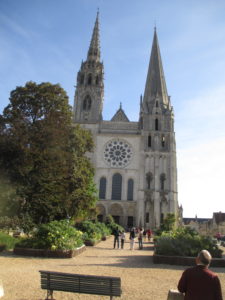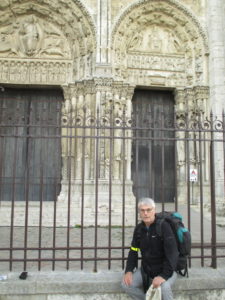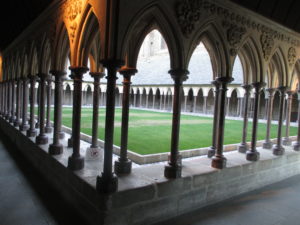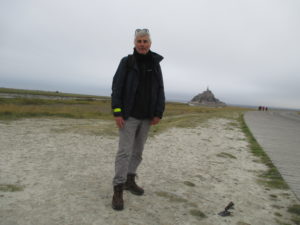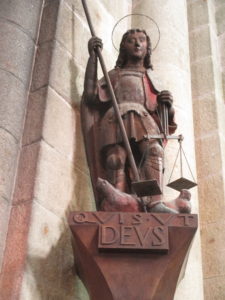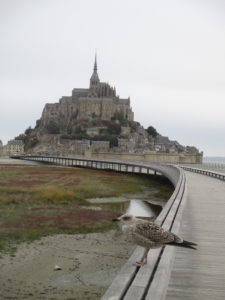
23 Jan Discovering Michael in the European Landscape by Michel Dongois *
In this article I shall attempt to convey the feeling of wonder I experienced when discovering how the ancient routes leading to Mont-Saint-Michel, “The Roads to Paradise”, have taken on new life. To date, seven of these pilgrimage routes have been mapped out, one of which begins at the cathedral of Chartres. This latter is the one I chose to take in September, starting at the Royal Portal of the cathedral and journeying on foot all the way to Mont-Saint-Michel. My intention was to connect two of the jewels of our civilisation, all the while strengthening my own connection with the Archangel whose name I bear.
I began my journey on the morning of September 11 as the mist rose over the river Eure. “You are now going to reorient your life by walking from birth to death”: these words were spoken by my host in Chartres who strolled alongside me for the first few kilometres. Indeed, as we shall see later, the very spirit of the two shrines connects the mysteries of incarnation** with those of death. In other words, the path leads from dawn to dusk, from East to West.
I followed rather closely the itinerary suggested by the Association des Chemins du Mont-Saint-Michel. On several occasions I became a bit frustrated when I lost sight of the trail markers in the fields and forests along the way, and I sometimes chose to take country roads or even highways, which were more direct. The scenic bike path, “la Véloscénie”, built in 2012 and connecting Paris to Mont-Saint-Michel by way of Chartres, gave me a sense of  being on both a pleasure excursion and a pilgrimage.
being on both a pleasure excursion and a pilgrimage.
Three weeks on the road – 320 km, 17 days on foot – filled me with a sense of pure delight. Sunlight and clear skies accompanied me almost the whole time. And, the greatest luxury of all – no cellphone, no computer, no screen. Only an 8 kg backpack. And, to remain in contact with my family in Canada, good old-fashioned letter writing.
Locations associated with Michael
The Association des Chemins du Mont-Saint-Michel, created in 1998, promotes the various routes to Mont-Saint-Michel and has created a European network of locations connected to Michael. Among these sites, which are generally located on promontories, the most renowned are the Monte Gargano (the oldest shrine to the Archangel in the West) and the Sacra di San Michele, in Italy; and, in the British Isles, St. Michael’s Mount and Skellig Michaël. The Association keeps the memory of Michael alive – in Brussels as well, and even as far as Finland. The presence of Michael is quite noticeable in France (chapels, abbeys, churches), and is sometimes associated with  Santiago de Compostela, as is the case with the church of Saint-Michel d’Aiguilhe, near the mount Pui-en-Velay, which serves as the starting point for four major roads to Santiago. The pilgrimage to the Archangel predates that of Compostela.
Santiago de Compostela, as is the case with the church of Saint-Michel d’Aiguilhe, near the mount Pui-en-Velay, which serves as the starting point for four major roads to Santiago. The pilgrimage to the Archangel predates that of Compostela.
According to René Querido,** Chartres cathedral celebrates the mysteries of the Virgin, of life and incarnation, and the Eternal Feminine. It houses the “chemise” – or veil – of the Virgin, that she was said to have worn at the birth of Jesus and which protected the infant. “Chartres has become the cloak for Mary-Sophia”. The author goes on to say that from the moment she gave birth to the Jesus Child, every human being has been given the power to be reborn. “This child represents, for each of us, the potential for our highest possible self to emerge” under the Archangel’s protection. This rebirth is called by René Querido the “Michael birth”.
Foundation Stones
Auguste Rodin was in awe of Chartres cathedral; “our Cathedral is splendid above all others! Is it not the French Acropolis?” A cathedral for prayer, and, according to my host, a favourite with German anthroposophists. As I ambled slowly inside the church, I found myself constantly gazing upwards. On the floor beneath the highest part of the ceiling, I noticed foundation stones, “pierres d’attente”, that were originally meant to support multiple spires, for the cathedral was originally conceived to represent the Heavenly Jerusalem. Only two of these were completed. This expectation (“attente”), which is also hope, provided me with a sign that I was on the right path. Did not the pilgrims of Saint Michael, the “Miquelots”, travel towards Mont-Saint-Michel as if they were journying towards the Heavenly Jerusalem, an earthly reflection of the heavens?
Due to its location in the West, Mont-Saint-Michel seems to evoke the process of excarnation, a faith in the survival of the soul in the great beyond. Is this what Victor Hugo meant when he stated that the Mount was to France what the Great Pyramid is to Egypt? In the Middle Ages, it was called “Mont-Saint-Michel, protector against the dangers of the sea”, and was seen as a sort of Guardian of the Threshold. This brought back to mind the old adage which says that there are three types of men: the living, the dead, and those who sail the seas. By virtue of the fact that he is in constant movement, the pilgrim can be seen as belonging to this third category.
I held these imaginations in my heart, while in my hand I carried the “Carnet du Miquelot” (The Michael Pilgrims’ day journal) furnished by the Association. I had it stamped at each stage of the journey, which prompted me to remain as aware as possible of each important stop along my way.
On the first evening, a lady guided me on a visit of the church at Neslay-le-Grenet with its frescos. La danse macabre,one of the best-preserved frescoes in Europe, portrays “The Story of the three dead and the three living”. Three skeletons are depicted speaking to three knights decked out in full array: “We were as you are, you shall be what we are”. And then, as if to assuage this experience of being faced with the inexorable, the lady went on to show me a moving sight: a medieval stone cross with two faces, depicting Christ on one side and the Virgin on the other.
Human Encounters
This sort of prolonged excursion brings one back to the basic necessities of life: eating and sleeping. It makes one vulnerable; one is constantly asking one’s way, asking for water, approaching other human beings. I frequently took advantage of the cafés along the way in order to rest my feet, feeling out the atmosphere of the countryside, inquiring about possible lodgings in the vicinity. Indeed, it is rather difficult to make reservations long in advance, because the progress of the pilgrimage depends greatly on weather conditions. Tourist offices and municipal services were of great help. It’s amazing to realize how quickly one’s morale is revived as soon as a place to sleep has been secured! The road can then once again open up for new discoveries and the joy of new acquaintances.
I was very often sent on my way with a friendly: “Good luck!” And I invariably replied: “I don’t need luck when I love what I am doing!” But I never forgot that in order for me to be able to walk this pilgrimage route, others had to agree to remain at home. And my appreciation went out to the bakery shops, which were often the only businesses remaining in many small villages, as in those of the Orne region. I knew that there I could always find a sandwich to carry me through my day. And I must confess that I did occasionally give in to the temptation of enjoying the odd custard pie or baba au rum.
The Spiritual Experience of being on the road
A long-distance walking journey is a veritable ode to life when the weather conditions are ideal. It can produce a feeling of love for the world around us, make our gaze more acute, and foster living, creative thinking. It especially opens one up to meetings with others, like the old woman who was so overjoyed to show me around the church in Livaie. Having been born in the neighbouring commune of “Le Cercueil” (The Coffin), she was sure of one thing – that she would one day return there!
The people I met were generally quite open to telling their life story and speaking of their joys and their concerns. They would sometimes ask me to pray for them or for their loved ones, and to have a thought for them once I reached the Mount. And in return, I told them my story. The transient nature of these encounters seemed to make it easier to share intimate details; and though these meetings were fleeting, they often turned quickly to the most serious topics. Much can be experienced in a short moment. Is this not one of the spiritual experiences of being on the road? But then there were also more passive signs of faith. Indeed, spiritual advice was not the only gift I was given – I received several images of the Holy Virgin, a Saint Michael rosary, testimonials from the Holy Mass of Catalina, and even a portrait of the Iroquois saint, Kateri Tekatwika!
I strove constantly to reconcile this feeling of sincere devotion with the ideas of Rudolf Steiner that I had so clearly inscribed in my pilgrim’s day journal. Indeed, according to Steiner, there is but one way to draw on the forces of Michael: “A human being must become, in full consciousness, by means of his own loving will, an instrument for divine spiritual forces. For the Michael forces do not respond to being petitioned by human beings; they want the human being to become their ally.” And he goes on to say that Michael answers when a human being has made a free resolve to act. “It is actions that serve as questions for Michael, and it is human deeds that he answers”.
Becoming Active
Human deeds! To experience a conscious working with the Archangel while walking towards his shrine is, though symbolic, such a deed. Becoming active – relearning how to become active – represents a first step, faithful to Christ’s threefold admonition: arise, take up your bed, and walk. And as if to prove the wisdom of this saying, at Domfront, quite unexpectedly, an elderly woman who almost never allowed pilgrims into her house, afforded me lodging for three days. Indeed, she hesitated to open her door to me, because her neighbours thought her very unwise to take in strangers. But the inner call to embrace our encounter won out. We had many rich conversations, and I helped her with picking chestnuts and doing small gardening chores. Upon leaving, I carried a bit of her destiny within me, and I had certainly left her with a bit of my own.
And I also reconnected, as I walked, with the spirit of “Royal France”, rediscovering along the way the richness of her civilisation. It could be discovered everywhere, in both landscape and architecture. In Domfront, one could still get a sense of the time when France and England were “united”, as they waged battle against one another in Normandy and elsewhere. In Mortain, I climbed up to the little chapel of Saint-Michel, from where I could make out in the distance the triangle shape of Mont-Saint-Michel. The little chapel borders on Hill 314, where German and American soldiers died in 1944. And not far from that spot, on the border between the Orne and the Manche, I discovered the “Fosse Arthour”, the pit in which Arthur and Guinevere are said to have drowned.
And then, after having gone through the hilly Perche region, and having trekked some ten kilometres along the Voie verte (Green way), I arrived quietly at the Mount on October 2nd. Thankfully, a pedestrian bridge has now replaced the hideous parking lot that previously disfigured the entrance to the “Merveille” (the great structures facing north towards the sea). I hurried to find the tourist office, where I obtained my “Miquelot” diploma by showing the pilgrim’s day journal I had had duly stamped at every stage along the route. An Australian couple, who had travelled the route on bicycle, were as overjoyed as I was.
For five days, I experienced the Mount, by day and by night, in the midst of bustling crowds and in moments of living, breathing silence. A mystical beauty reigned over the Office des Laudeswhen fierce rain and raging wind fought to bury the human voices praying inside. There were moments of deep contemplation, sometimes tinged with strange mental images as, in the moonlight, I climbed the 300 steps leading from the monks’ quarters to the abbey.
The Weighing of Souls
In Hebrew, the name Michael means “Who is like God”. A very positive affirmation, or so I thought. And then I discovered that in several documents the affirmative is replaced by the interrogative form: “Who is like God?” I was struck by the thought that my given name could actually be a question. And this, in a flash, opened up the whole question of personal freedom and choice – as if it were an invitation to come to Christ by way of the Archangel.
Michael is best known as the warrior who slays the dragon. And at the Mount, this is indeed the predominant image. But what dragon? Lucifer? Ahriman? There are many fewer images of him portrayed as the guide who escorts souls as they pass beyond the threshold into death. The Catholic church petitions Michael in the prayer for the dying as the protector of souls who are leaving this life. I sought for images of Michael carrying out the “weighing of souls” at the last judgment. I only found two of these. The more discreet of the two was on the parish altar of Saint Peter; Peter is associated with the Archangel as the keeper of the doors to heaven. The second was a polychrome wooden statue dating from the 15thcentury, which stands at the entrance to the choir of the abbey.
I stood for a long while contemplating this statue. Michael is depicted there serving in his two essential functions. He is obviously both the protector of all mankind in his capacity as warrior, and at the same time the guide for individual souls passing over into the realm of death. This seems to fit the traditional ancient iconography. Holding both sword and scale, he appears to fulfill his twofold task with an almost maternal, soothing gesture, as if waging battle yet remaining devoid of all hatred. And by wielding the scale, he seems to be urging us to put our destiny in order. Are we to be judged according to the effort we have exerted? Not only that, said a fellow pilgrim to whom the statue also seemed to “speak”. She reminded me of the parable of the labourers of the 11thhour, which is also an example of divine intervention.
Maritime Tradition
I then decided to observe the Mount from the new dam that was constructed to regulate the flow of the Couesnon, the river that marks the boundary between Normandy and Brittany. The work to remove the excess sand that had been deposited over the years around the Mount was herculean in scope, but now the waters flow again and the tides ebb and subside freely. This is proof that man can repair what he himself has spoiled – and indeed this is the substance of what president François Hollande declared upon the completion of the project in 2015.
Just as Chartres was a centre of learning under Bishop Fulbert and others,** the Mount was itself a hub of knowledge; the wisdom contained in its scriptorium and library was disseminated far and wide. The Scriptorial d’Avranchetoday houses the manuscripts and other documents for which the abbey of the Mount received the name “Cité des livres”. In order to highlight the prestige and the calligraphic excellence of the monks, the letters of four alphabets (Latin, Greek, Hebrew, and Arabic) have been engraved on the handrail above the dam as an acknowledgment of the intermingling of Western and Eastern cultures.
The Mount is 1300 years old. According to legend, the Archangel had to appear three times to Aubert, the bishop of Avranches, before convincing him to erect a shrine to Michael on Mount Tombe. The Archangel is said to have driven his finger of light into the bishop’s skull – hence the perforated skull on display in one of the town’s churches. I reflected upon the fact that Michael had brought cosmic intelligence down to the earth, both here and at the labyrinth in Chartres, which can be construed as resembling, among other interpretations, the convolutions of the human brain.
Looking Back
And then, from my vantage point on the abbey’s terrace, I reflected upon my own “Paradise Road”, with all its stops and the people I had met along the way. I visualized the statues, the imagery of the stained-glass windows of Chartres, the parched plains of the Beauce region where the dust created a sense of impending desert, the mystical forest of Andaines, the characteristic “bocage” farmland of Normandy with its meadows crisscrossed by hedges and trees.
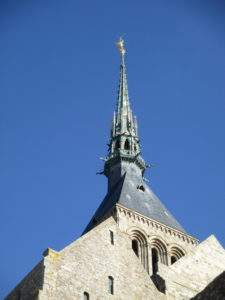 I also thought back to the spires of the cathedral at Chartres topped with symbols of the Apocalypse – the Woman of the Sun and the crescent moon. Are these not the very same forces we see reflected at the Mount, where the lunar play of the tides seems to guide the sun-like rays streaming from the statue of the Archangel? His flaming sword appears to sweep the sky as he stands a full 156 metres above sea level.
I also thought back to the spires of the cathedral at Chartres topped with symbols of the Apocalypse – the Woman of the Sun and the crescent moon. Are these not the very same forces we see reflected at the Mount, where the lunar play of the tides seems to guide the sun-like rays streaming from the statue of the Archangel? His flaming sword appears to sweep the sky as he stands a full 156 metres above sea level.
Before leaving the Mount, I came across a book by Jean-Jacques Antier called Le pèlerinage retrouvé (Pilgrimage Rediscovered). The author explains how the pilgrim relives his life in reverse order, leaving behind what is old, his former habits, in order to hasten towards eternal youth on a path of renewal. “The more he advances in years, the more youthful he becomes. His youth is not behind him but rather ahead of him. For this road travelled inwardly brings him ever closer to the source of life – the Christ.” And Michael is a royal road towards Christ. Comparing the route of the pilgrim with a process of rejuvenation reminded me of what Rudolf Steiner said about the life body, which, contrary to the physical body, is born old and becomes younger as we advance towards old age.
The fact that contemporary society is connecting once again with its Michaelic heritage is consistent with an impulse living in today’s European culture – taking stock of one’s core values. And this impulse is intensifying as we sink progressively lower into the virtual universe of technology. Another European itinerary is in preparation, this time the goal will be to follow the path of the Templars (France and Portugal). The French department of the Aube is intimately connected with the birth of the Order of the Templars; and the commune of Tomar houses the last provincial headquarters of the Templars in Europe. The Aube and Tomar represent the alpha and omega of the history of the Templars, according to the promoters who are developing the itineraries for the route.
And as for the Archangel, I have not forgotten the fact that he crossed the Atlantic! I’m planning to get the last stamp in my “Miquelot” pilgrim’s day journal in the islands of Saint-Pierre-et-Miquelon, bordering on Canadian waters – but this time I’ll not venture on foot!
*Retired Journalist. Member of the Anthroposophical Society in Canada.
**The Golden Age of Chartres,The Teachings of a Mystery School and the Eternal Feminine.René Querido. Floris Books. The author takes his inspiration from Rudolf Steiner’s indications on Chartres.
